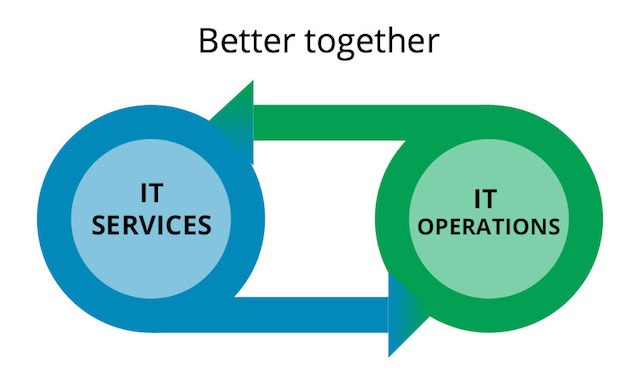Why You Should Integrate Your IT Services With Your IT Operations
When IT services and IT operations are integrated, incident management if faster and more efficient, speeding up deployments and preventing software security risks.
Join the DZone community and get the full member experience.
Join For FreeDepartments within an organization must be able to easily coordinate and cooperate with each other to optimize productivity. Even though this kind of collaboration isn't always easy, it fosters organizational stability. While organizations comprise many departments, the IT department is the driving force behind the organization. That's why maintaining a stable IT department is a key objective for any organization.
IT management is supported by two major domains: IT services and IT operations. The ultimate goal of IT services is to design, manage, deliver, and improve information technologies that are used within the organization, while IT operations deal with the administrative side of things. IT operations handle individual application requirements, manage storage and networking, and troubleshoot users' devices to resolve issues. Organizations employ a help desk solution for their IT services needs and a desktop management solution for their IT operations needs. Understanding how IT services and IT operations influence end user support requires a deeper look into why IT departments need a help desk solution and a desktop management solution in the first place.
Help Desks: The Key to Effective Ticket Management
Whenever a user faces an issue with their company laptop, they raise a ticket with their IT department. A technician then deals with the ticket one step at a time, escalating the request as necessary until the issue is resolved. Raising requests may not seem alarming initially, but as organizations grow and technicians' inboxes pile up with tickets, support requests may become a matter of concern. Given that help desk software can completely facilitate ticket handling for your technicians, you can imagine how hard it would be to handle those tickets without all the automation a help desk provides. Help desks have become a key for effective incident management across various industries.
Desktop management solutions manage assets and address vulnerabilities in other IT operations like software deployment, patch management, asset management, mobile device management, and remote control operations. When vulnerabilities aren't addressed in time, they can turn into a gateway for hackers to breach your enterprise systems and tap into confidential information. This can be avoided with proper patch management across heterogeneous platforms using the right endpoint management solution.
As you can see, IT services and IT operations play a major role in IT management, but the overall efficiency of your IT management truly increases when they are integrated. Take a look at the scenario below to see how integrating IT services and IT operations streamlines IT management.The problem with IT silos
Consider a scenario where an employee raises a request for new software:
- A user request generates a ticket that is sent to a help desk technician.
- The help desk technician reads the ticket and understands the requirement.
- The technician forwards the request to the right technician for proper handling.
- The system administrator installs the software for the user.
- After installation, the system administrator updates the status of the ticket and sends it back to the technician.
- The help desk technician closes the ticket.
Each step of this lengthy workflow is performed one after the other continuously, provided that the help desk technician and the system administrator are available at all times. If either of them isn't fully available, the process of installing software for the end user and closing the ticket quickly becomes more time-consuming.
IT Services and IT Operations: Better Together
Consider the same scenario where an employee requests new software. However, in this case, the organization has integrated their help desk and desktop management tools.

- A user request generates a ticket that is sent to a help desk technician.
- The help desk technician reads the ticket and understands the requirement.
- The technician selects the requested software from a list of available software packages and deploys the software to the user's computer.
- Once the installation finishes, the technician closes the ticket.
The technician can easily access a list of available software packages because the organization's IT services are integrated with their IT operations. The overall workflow here is streamlined, taking much less time to process the end user's request.The scenario discussed above is just one example, whereas there are many other scenarios where the need to troubleshoot remotely, patch remote systems, manage mobile devices, etc., makes this integration even more critical and improves your IT management efficiency, which is why most of the leading help desk and desktop management solutions on the market offer some sort of integration. Start integrating your help desk and desktop management solutions to increase the efficiency of your IT operations and services now.
Opinions expressed by DZone contributors are their own.

Comments